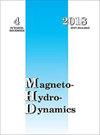Numerical study of the induced electric current of electrovortex flow in a cuboid vessel: electric scalar and magnetic vector potential formulations
IF 0.3
4区 工程技术
Q4 MECHANICS
引用次数: 0
Abstract
Motivated by the development of liquid metal batteries, the electrovortex flow of a liquid metal confined in a cuboid vessel is numerically studied. The electric scalar and magnetic vector potential formulations are implemented in the COMSOL Multiphysics software for the solution of the magnetohydrodynamic equations. In particular, a liquid metal is driven by a Lorentz force produced by the interaction of an axial electric current and the magnetic field generated by either one or a pair of magnets. Velocity profiles were compared with experimental measurements reported in the literature and a good comparison was observed. The induced electric currents are calculated using both Ohm's and Ampere's laws. The induced electric current distribution due to the liquid metal flow is analysed for the interaction parameter in the range of experimental conditions. Figs 5, Refs 17.长方体容器内电涡流感应电流的数值研究:电标量和磁矢量势公式
受液态金属电池发展的推动,对受限于长方体容器中的液态金属的电涡流进行了数值研究。电标量和磁矢量势公式在COMSOL Multiphysics软件中实现,用于求解磁流体动力学方程。特别地,液态金属由洛伦兹力驱动,洛伦兹力由轴向电流和由一个或一对磁体产生的磁场的相互作用产生。将速度剖面与文献中报道的实验测量结果进行了比较,并观察到了良好的比较。感应电流使用欧姆定律和安培定律进行计算。在实验条件范围内,分析了由液态金属流动引起的感应电流分布的相互作用参数。图5,参考文献17。
本文章由计算机程序翻译,如有差异,请以英文原文为准。
求助全文
约1分钟内获得全文
求助全文
来源期刊

Magnetohydrodynamics
物理-力学
CiteScore
1.20
自引率
14.30%
发文量
37
审稿时长
6-12 weeks
期刊介绍:
Information not localized
 求助内容:
求助内容: 应助结果提醒方式:
应助结果提醒方式:


